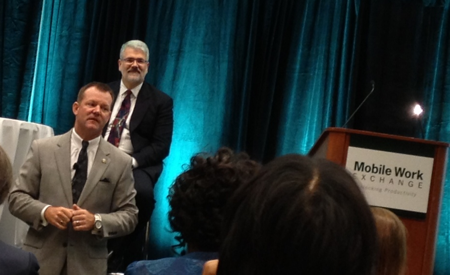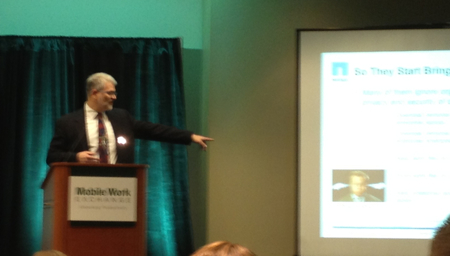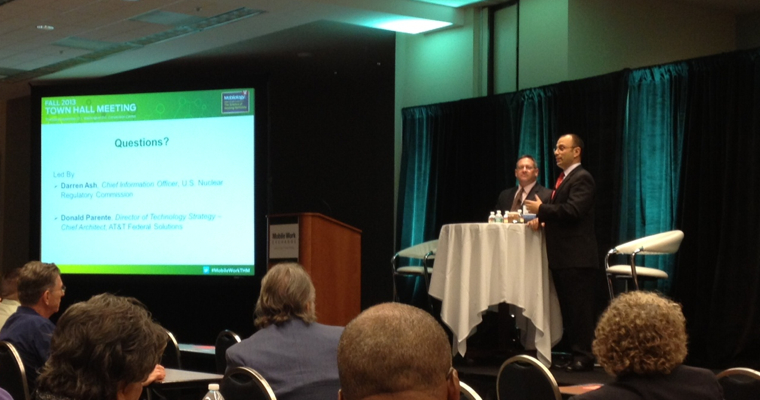Mobility Is About Data, Devices and Demand
For federal employees, work is no longer a place; it’s a verb. That’s how the Bureau of Alcohol, Tobacco, Firearms and Explosives CIO Rick Holgate describes the impact of mobility on productivity in government. Employees want to work with their own tools at home, in coffee shops and sometimes in an office. The government, Holgate says, should be accepting of this new approach to work, since it offers opportunities for both decreased costs and increased productivity. But first, agencies need to figure out exactly how they plan to tackle mobility.

Credit: Jimmy Daly
Rob Anderson explains how the U.S. Marine Corps is using dual-persona technology to enable mobility.

Dale Wickizer, NetApp Public Sector Chief Technology Officer, discusses the real issue with BYOD: data.
"#BYOD is a data management issue, not a device issue." - @dalewickizer #MobileWorkTHM
— James Alan Miller (@JamesAlanMiller) September 12, 2013
Today, mobility is about so much more than just devices. It encompasses technologies like cloud, data loss prevention, virtualization and policies like BYOD. The quickly evolving mobile landscape and, more importantly, employees’ demands for modern, user-friendly technology are forcing agencies to rethink how and where data is stored as well as where and how it can be accessed. The challenges have created a lot of uncertainty in government, but agencies are beginning to find solutions. Many of these mobility leaders gathered at the Mobile Work Exchange Town Hall to share their findings.
Personally Owned, Marine Corps Enabled
Rob Anderson, Chief, Vision and Strategy Division for HQMC/C4 of the U.S. Marine Corps, is experimenting with dual personas on his agency's mobile devices. After discussing potential BYOD strategies with agency leaders, they decided to pursue a “personally owned, corporate enabled” model, where personal devices can run two entirely separate operating environments. One container is used for organizational productivity and personal computing while the other is reserved for classified data. The containers never interact, and data does not spill from one container into the other. The Marine Corps can monitor, restrict and encrypt data on the classified side but has no access to the personal side. A pilot program to test the model is beginning this fall.
The technology sounds more expensive than it is. When asked about the cost, Anderson noted that he was very pleased with the pricing of these devices, although no exact cost was discussed. Fifty-five percent of the Marine Corp’s mobility costs have been spent on the maintenance of licenses, software and policies. This approach, along with a training course for participating end users stands to save the agency operating costs in both the short and the long term.
Virtually the Perfect Solution
Dual-persona technology is one way to address the security concerns brought about by mobility, but the Nuclear Regulatory Commission has taken a different approach. CIO Darren Ash began his session, “Virtualization Valedictorian,” with a question: “Why do we care about virtualization when it comes to mobility?” The answer, which he provided later in the presentation, is simple: Mobility “can’t just be about e-mail, calendar and contacts. We need to provide a richer work environment.” Virtual desktop infrastructure is one way his agency is providing employees with remote productivity tools.

Donald Parente, director of technology strategy and chief architect for AT&T Federal Solutions, offered an analogy to explain how virtualization is helping agencies secure data and promote a mobile workforce. It used to be that secure files were stored in a file cabinet. There were only a few keys, and physical security was a great concern. Now, all of the data in those file cabinets enters and exits agency offices via laptops and mobile devices every day. Virtualization is a way to centralize data again, so that it’s easier to safeguard. As for access, it can be distributed to those who need it when they need it, via thin clients (which are considerably less expensive than laptops and don’t need to be refreshed as often).
The impact of other technologies and the nature of employee productivity make it impossible for federal agencies to tuck mobility into a silo. Driven by employee demand and shrinking budgets, agencies are getting creative with their approaches to this important technology.








